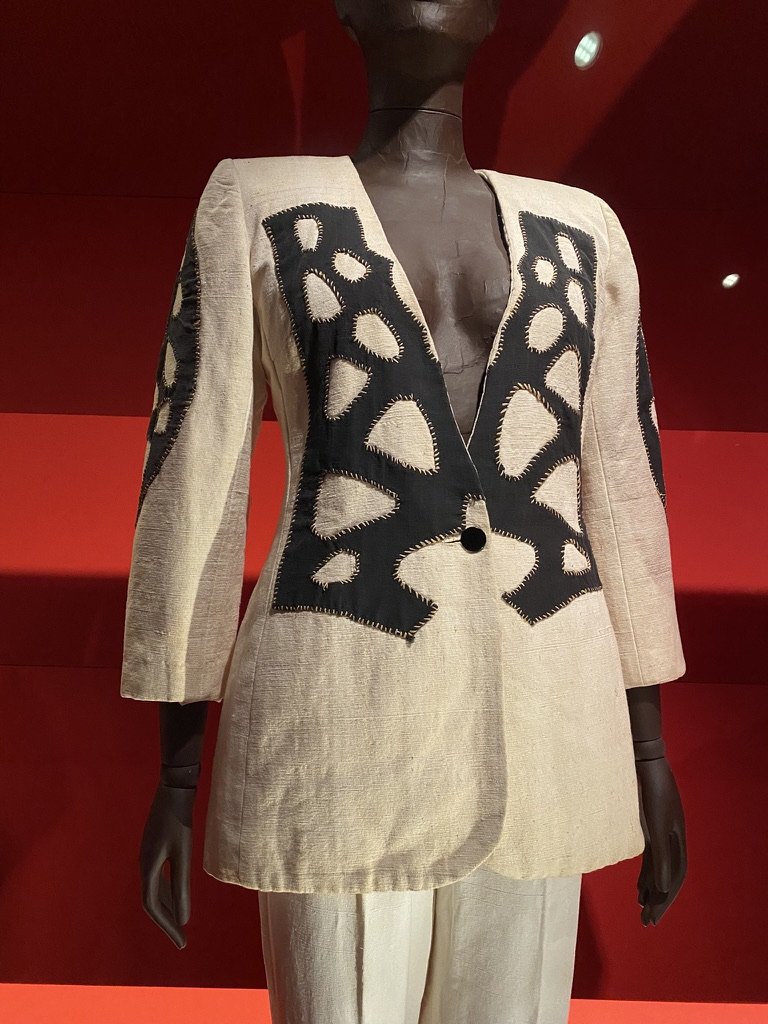The Coexistence of Past and Present Tradition Through “Africa Fashion”
The Victoria and Albert Museum in London houses a collection of numerous art and design works. In this museum, I focused on the “Africa Fashion” exhibit. This exhibit showcases how creatives are changing the way the world views fashion in Africa. “Africa Fashion” reveals how fashion serves as a form of self expression, storytelling, and innovation.
Not only do the designers featured in this exhibit showcase the history of fashion in Africa, but they share a modern perspective of how the past shapes contemporary fashion in Africa. I appreciate that the V&A recognizes their faults in repeatedly excluding creativity in Africa. The V&A wishes to embrace African narratives and give voice to underrepresented artists and designers.
Trouser Suit, Chris Seydou, 1992, Mali. Cotton, applique embellishment.
In Africa Fashion, the past and present coexist in a beautiful way. Artists connect childhood, family, and life experiences with advanced design skills and sewing techniques. Colors and textiles of Africa upgrade to modern silhouettes and gain status in the high fashion realm. This exhibit brings attention to an ignored segment in fashion– a continent that has been historically overlooked. Africa has a rich history of fashion, art, and culture, which the exhibit translates through calming music, visually stimulating displays, and the incredible feeling visitors experience while exploring each room.
Chris Seydou’s trouser suit, created in 1992 in Mali, exemplifies the purpose of the exhibit. This piece immediately drew my attention because of the applique embellishment and incredible tailoring. The outfit consists of a textured cotton material, single button, and intriguing mix of hand stitched dark fabric with cutouts. The cutouts seem inspired by animal print, and the contrast stitching emphasizes this texture and close attention to detail. Chris Seydou took textiles traditionally used in his childhood and elevated this cloth to runway-ready looks. The bogolanfini cloth reminds Chris Seydou of his childhood, and therefore he honors its significance through signature patterns and craftsmanship in the applique design.
“Jossa” top and trousers, Spring/Summer 2021. Lagos, Nigeria. Printed silk and cotton (top); Ankara (resist-printed cotton) and glass beads (trousers).
Secondly, Lisa Folawiyo’s “Jossa” top and trousers pays homage to the designer’s background. Lisa created the ensemble in Lagos, Nigeria for Spring/Summer 2021. Folawiyo is not afraid to contrast textures, patterns, and bold colors, to make her designs stand out and showcase personal storytelling. Like Seydou’s use of traditional bogolanfini cloth, Lisa Folawiyo celebrates her heritage and incorporates Ankara printed cloth, which has been worn by generations that came before her. I feel intrigued by Lisa’s creativity in layering garments and patterns intentionally, and her attention to detail in pleats and beadwork inspires my own fashion design.
Finally, the work by Nkwo Onwuka impressed me immediately because of the mixed textiles. The V&A conveys the purpose of the exhibit through Onwuka’s work because she collaborates with up-and-coming skilled artisans around Africa in her production process. Onwuka’s work was my favorite of the exhibit, because of the beautiful upcycled textiles. I am passionate about sustainability, so I appreciate that Onwuka used her design talents to invent “Dakala Cloth,” which weaves scrap fabrics back together.
Each of the pieces I focused on integrate tradition with modern fashion, and honor the influence of Africa’s history by showcasing techniques that have been passed down through generations. While the garments differ in texture, color, and silhouettes, the common theme of Africa’s vibrant fashion remains.
Oftentimes with art, we focus so much on the present and future that we forget how much influence the past has over one’s creativity. When visitors leave the V&A’s Africa Fashion exhibit, they gain a greater appreciation for the way the past influences the perspective of the present, and how important it is to preserve tradition and appreciate underrepresented artists. Additionally, Africa Fashion will pave the way for the V&A and other major art museums to showcase more diverse backgrounds, so that no country is overlooked. The V&A realizes that so much valuable art gets left out, especially when curators have a certain bias or lens through which they view fashion. The fact that the curators put together such an informative and spectacular exhibit excites me for what’s to come in the future fashion exhibition space.
xoxo,
Josie
“Namod” dress and shoes. BE US, BE THEM collection, Spring/Summer 2020. Abuja, Nigeria. Denim and recycled nylon (dress); plastic (shoes).
Jacket, skirt, bra, gèlè and shoes. WHO KNEW collection, Spring/Summer 2019. Abuja, Nigeria. Denim, flax, glass, plastic (jacket and bra); bleached denim (skirt); plastic (gèlè); plastic (shoes).



